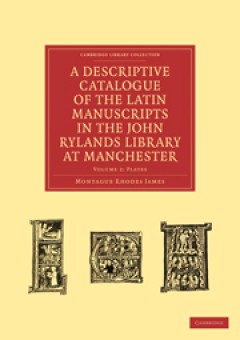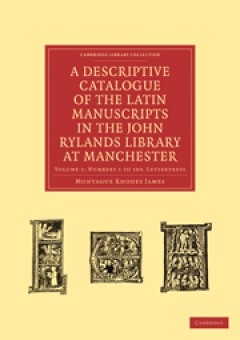Filter by

A Descriptive Catalogue of the Manuscripts in the Library of Lambeth Palace
M. R. James (1862–1936) is probably best remembered as a writer of chilling ghost stories, but he was an outstanding scholar of medieval literature and palaeography, who served as Provost of King's College, Cambridge, and Director of the Fitzwilliam Museum, and later became Provost of Eton College. His detailed descriptive catalogues of manuscripts owned by colleges, cathedrals and museums ar…
- Edition
- -
- ISBN/ISSN
- 9780511919954
- Collation
- -
- Series Title
- Cambridge Library Collection - History of Printing, Publishing and Libraries
- Call Number
- -

A Descriptive Catalogue of the Manuscripts in the Library of Jesus College
M. R. James (1862–1936) is probably best remembered as a writer of chilling ghost stories, but he was an outstanding scholar of medieval literature and palaeography, who served both as Provost of King's College, Cambridge, and as Director of the Fitzwilliam Museum, and many of his stories reflect his academic background. His detailed descriptive catalogues of manuscripts owned by colleges, ca…
- Edition
- -
- ISBN/ISSN
- 9780511702952
- Collation
- -
- Series Title
- Cambridge Library Collection - History of Printing, Publishing and Libraries
- Call Number
- -

A City in the Republic: Antebellum New York and the Origins of Machine Politics
This study of the emergence of machine politics in New York City during the antebellum years sheds light on the origins of a system that was the characteristic form of government in United States cities from the mid-nineteenth until well into the twentieth century. In contrast to previous explanations that have found the origins of machine politics in immigrant culture and ethnic conflict, Prof…
- Edition
- -
- ISBN/ISSN
- 9780511895920
- Collation
- -
- Series Title
- -
- Call Number
- -

A Descriptive Catalogue of the Manuscripts in the Library of Gonville and Cai…
M. R. James (1862–1936) is probably best remembered as a writer of chilling ghost stories, but he was an outstanding scholar of medieval literature and palaeography, who served both as Provost of King's College, Cambridge, and as Director of the Fitzwilliam Museum, and many of his stories reflect his academic background. His detailed descriptive catalogues of manuscripts owned by colleges, ca…
- Edition
- -
- ISBN/ISSN
- 9780511702150
- Collation
- -
- Series Title
- Cambridge Library Collection - History of Printing, Publishing and Libraries
- Call Number
- -

A Chemical and Medical Report of the Properties of the Mineral Waters: Of Bux…
In medical terms, 'mineral water' was, in the early nineteenth century, any water that appeared to have an effect on human health. British physicians often prescribed mineral waters from particular locations - most commonly those at Bath - for a variety of illnesses. However, there was little available information on the chemical composition of these waters, and extant manuals were often inaccu…
- Edition
- -
- ISBN/ISSN
- 9781139839273
- Collation
- -
- Series Title
- -
- Call Number
- -

A Descriptive Catalogue of the Manuscripts in the Library of Eton College
M. R. James (1862–1936) is probably best remembered as a writer of chilling ghost stories, but he was an outstanding scholar of medieval literature and palaeography, who served both as Provost of King's College, Cambridge, and as Director of the Fitzwilliam Museum, and many of his stories reflect his academic background. His detailed descriptive catalogues of manuscripts owned by colleges, ca…
- Edition
- -
- ISBN/ISSN
- 9780511919916
- Collation
- -
- Series Title
- Cambridge Library Collection - History of Printing, Publishing and Libraries
- Call Number
- -

A Descriptive Catalogue of the Manuscripts in the Library of Corpus Christi C…
M. R. James (1862–1936) is probably best remembered as a writer of chilling ghost stories, but he was an outstanding scholar of medieval literature and palaeography, who served both as Provost of King's College, Cambridge, and as Director of the Fitzwilliam Museum, and many of his stories reflect his academic background. His detailed descriptive catalogues of manuscripts owned by colleges, ca…
- Edition
- -
- ISBN/ISSN
- 9780511703560
- Collation
- -
- Series Title
- Cambridge Library Collection - History of Printing, Publishing and Libraries
- Call Number
- -

A Descriptive Catalogue of the Manuscripts in the Fitzwilliam Museum
M. R. James (1862–1936) is probably best remembered as a writer of chilling ghost stories, but he was an outstanding scholar of medieval literature and palaeography, who served both as Provost of King's College, Cambridge, and as Director of the Fitzwilliam Museum, and many of his stories reflect his academic background. His detailed descriptive catalogues of manuscripts owned by colleges, ca…
- Edition
- -
- ISBN/ISSN
- 9780511693830
- Collation
- -
- Series Title
- Cambridge Library Collection - History of Printing, Publishing and Libraries
- Call Number
- -

Get access
M. R. James (1862–1936), best known as a writer of chilling ghost stories, was an outstanding scholar of medieval literature and palaeography, who served both as Provost of King's College, Cambridge, and as Director of the Fitzwilliam Museum. His detailed descriptive catalogues of manuscripts owned by colleges, cathedrals and museums are still of value to scholars today. This two-volume catal…
- Edition
- -
- ISBN/ISSN
- 9780511919930
- Collation
- -
- Series Title
- Cambridge Library Collection - History of Printing, Publishing and Libraries
- Call Number
- -

A Descriptive Catalogue of the Latin Manuscripts in the John Rylands Library …
M. R. James (1862–1936), best known as a writer of chilling ghost stories, was an outstanding scholar of medieval literature and palaeography, who served both as Provost of King's College, Cambridge, and as Director of the Fitzwilliam Museum. His detailed descriptive catalogues of manuscripts owned by colleges, cathedrals and museums are still of value to scholars today. This two-volume catal…
- Edition
- -
- ISBN/ISSN
- 9780511919930
- Collation
- -
- Series Title
- Cambridge Library Collection - History of Printing, Publishing and Libraries
- Call Number
- -
 Computer Science, Information & General Works
Computer Science, Information & General Works  Philosophy & Psychology
Philosophy & Psychology  Religion
Religion  Social Sciences
Social Sciences  Language
Language  Pure Science
Pure Science  Applied Sciences
Applied Sciences  Art & Recreation
Art & Recreation  Literature
Literature  History & Geography
History & Geography